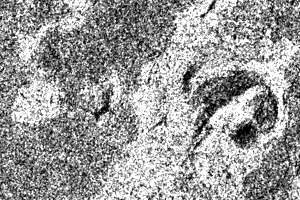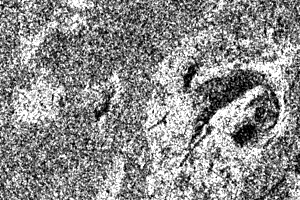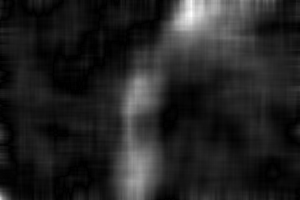KullbackLeiblerDistanceChDet.cxx¶
This example illustrates the class otb::KullbackLeiblerDistanceImageFilter for detecting changes between pairs of images. This filter computes the Kullback-Leibler distance between probability density functions (pdfs). In fact, the Kullback-Leibler distance is itself approximated through a cumulant-based expansion, since the pdfs are approximated through an Edgeworth series.
The Kullback-Leibler distance is evaluated by:

where:

 ,
,  ,
,  and
and  are the cumulants up to order 4 of the random variable
are the cumulants up to order 4 of the random variable  .
These correspond to 2 Radarsat fine
mode acquisitions before and after a lava flow resulting from a
volcanic eruption.
.
These correspond to 2 Radarsat fine
mode acquisitions before and after a lava flow resulting from a
volcanic eruption.
The program itself is very similar to the ratio of means detector, implemented in otb::MeanRatioImageFilter. Nevertheless the corresponding header file has to be used instead.
 |
 |
 |
Result of the Kullback-Leibler change detector
Example usage:
./KullbackLeiblerDistanceChDet Input/GomaAvant.png Input/GomaApres.png Output/KLdistanceChDet.png 35
Example source code (KullbackLeiblerDistanceChDet.cxx):
#include "itkMacro.h"
#include "otbImage.h"
#include "otbImageFileReader.h"
#include "otbImageFileWriter.h"
#include "itkUnaryFunctorImageFilter.h"
#include "itkRescaleIntensityImageFilter.h"
#include "otbKullbackLeiblerDistanceImageFilter.h"
int main(int argc, char* argv[])
{
if (argc != 5)
{
std::cerr << "Change detection through a Kullback-Leibler measure (which is a distance between local distributions)\n";
std::cerr << "Kullback-Leibler measure is optimized by a Edgeworth series expansion\n";
std::cerr << argv[0] << " imgAv imgAp imgResu winSize\n";
return 1;
}
char* fileName1 = argv[1];
char* fileName2 = argv[2];
char* fileNameOut = argv[3];
int winSize = atoi(argv[4]);
const unsigned int Dimension = 2;
using PixelType = double;
using OutputPixelType = unsigned char;
using ImageType = otb::Image<PixelType, Dimension>;
using OutputImageType = otb::Image<OutputPixelType, Dimension>;
// The KullbackLeiblerDistanceImageFilter is templated over
// the types of the two input images and the type of the generated change
// image, in a similar way as the MeanRatioImageFilter. It is
// the only line to be changed from the ratio of means change detection
// example to perform a change detection through a distance between
// distributions.
using FilterType = otb::KullbackLeiblerDistanceImageFilter<ImageType, ImageType, ImageType>;
// The different elements of the pipeline can now be instantiated. Follow the
// ratio of means change detector example.
using ReaderType = otb::ImageFileReader<ImageType>;
using WriterType = otb::ImageFileWriter<OutputImageType>;
ReaderType::Pointer reader1 = ReaderType::New();
reader1->SetFileName(fileName1);
ReaderType::Pointer reader2 = ReaderType::New();
reader2->SetFileName(fileName2);
// The only parameter for this change detector is the radius of
// the window used for computing the cumulants.
FilterType::Pointer filter = FilterType::New();
filter->SetRadius((winSize - 1) / 2);
// The pipeline is built by plugging all the elements together.
filter->SetInput1(reader1->GetOutput());
filter->SetInput2(reader2->GetOutput());
using RescaleFilterType = itk::RescaleIntensityImageFilter<ImageType, OutputImageType>;
RescaleFilterType::Pointer rescaler = RescaleFilterType::New();
rescaler->SetInput(filter->GetOutput());
rescaler->SetOutputMinimum(0);
rescaler->SetOutputMaximum(255);
WriterType::Pointer writer = WriterType::New();
writer->SetFileName(fileNameOut);
writer->SetInput(rescaler->GetOutput());
writer->Update();
}